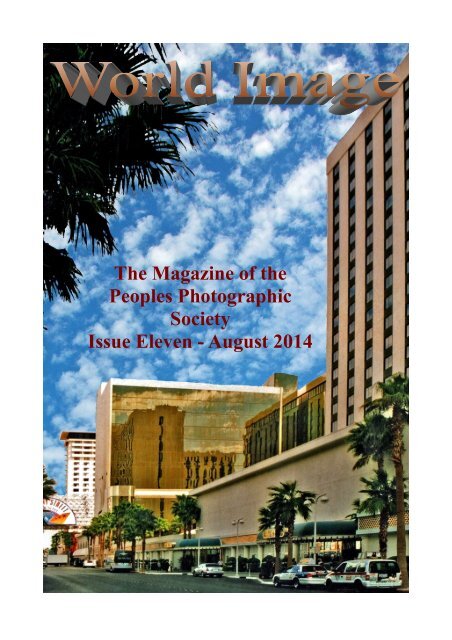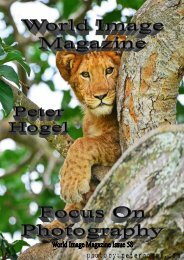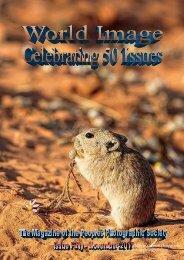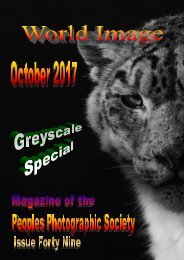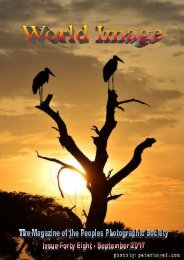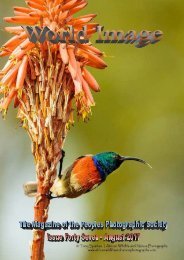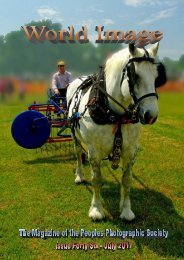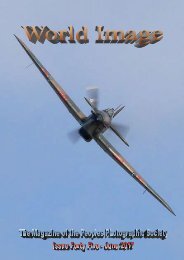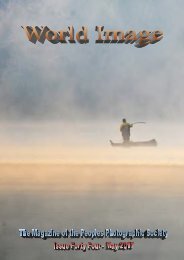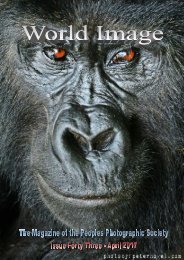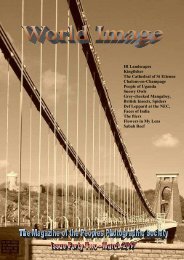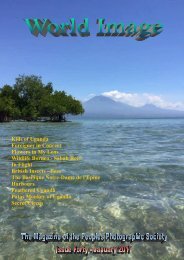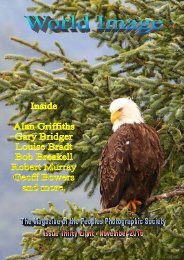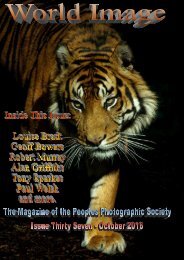World Image issue 11 October 2014
The Journal of the Peoples Photographic Society. Published on the 25th of each month, the latest edition is at: www.photosociety.net
The Journal of the Peoples Photographic Society. Published on the 25th of each month, the latest edition is at: www.photosociety.net
- No tags were found...
Create successful ePaper yourself
Turn your PDF publications into a flip-book with our unique Google optimized e-Paper software.
The Magazine of the<br />
Peoples Photographic<br />
Society<br />
Issue Eleven - August <strong>2014</strong><br />
Website = photosociety.net Page 1 email = magazine@photosociety.net
Society Management<br />
Management Committee:<br />
Gordon Longmead - England<br />
Peter Hogel - Tanzania<br />
Dave Walster - England<br />
Scott Hurd - Namibia<br />
Tom Coetzee - South Africa<br />
Alexander Rostocil - Kenya<br />
Paul Welch—Australia<br />
Steve Cook - USA<br />
Robert Murray - Scotland<br />
Regional Co-ordinators:<br />
Arusha, Tanzania - Peter Hogel<br />
Benton, Kentucky, USA - Jack Glisson<br />
East Herts UK - Gordon Longmead<br />
Lincoln UK - Dave Walster<br />
North Scotland, UK - Robert Murray<br />
Peak District, UK - Kev Sidford<br />
Yorkshire UK - Rodger Lee<br />
In this months <strong>issue</strong>:<br />
3 Chairman's Bit - Your Society<br />
5 Costa Rica - Peter Hogel - Tanzania/Uganda<br />
8 September Exhibition <strong>2014</strong><br />
9 Blog Spot - Skills in Photography - In the Beginning<br />
12 Toubkai Climbing, Morocco by Ibrahim Jellah, Morocco<br />
13 Transforming Portrait Photography Into Photoart - Gordon Longmead<br />
16 So who actually invented photography? - Gordon Longmead<br />
17 On the Buses - Kev Sidford, England<br />
22 Pentax K10d - User Review - Gordon Longmead<br />
24 A Personal Ramble - Phillip Tureck, England<br />
28 Capturing Lightening - Paul Welch, Australia<br />
31 Cycling in Cuba - Tina Andreasson, Sweden<br />
35 Tour Operators and Advertisers<br />
Cwm Idwal, Snowdon, Wales - Gordon Longmead<br />
© Please remember that all articles and images published in this magazine are copyright protected<br />
Cover Picture Lincoln, Nebraska, by Gordon Longmead<br />
Website = photosociety.net Page 2 email = magazine@photosociety.net
Chairmans Bit - Your Society<br />
The Peoples Photographic Society was founded<br />
in September 2013. In the first couple of weeks<br />
after we formed we had gained just 27 members<br />
of whom three have since withdrawn due to<br />
workload.<br />
Although people come and go, our current<br />
membership stands at 450 people across the<br />
four society profiles. Many of these are<br />
associate members through linked-in, <strong>World</strong><br />
image Magazine Group, and the Facebook<br />
group. Also in the last few weeks, we have<br />
established a blog page. Although still in its<br />
infancy, it has started to develop a following.<br />
The really pleasing aspect of the Society is that<br />
we currently have registered and associate<br />
members in 29 countries, but we are apparently<br />
being followed in 47 countries.<br />
The second count shows the overall number of<br />
visitors currently 6397, this was included on the<br />
29th April <strong>2014</strong> to show us how many people<br />
are returning to view the site.<br />
This number should increase much faster than<br />
the first, but only if you take the time to revisit<br />
the website.<br />
We have changed the management structure of<br />
the society so that we might better represent the<br />
society when talking to companies.<br />
In order to find new ways of promoting the<br />
Society, we recently asked members to share<br />
the post about the <strong>issue</strong> of the last magazine<br />
from the open page at https://<br />
www.facebook.com/1worldimage to their own<br />
timelines.<br />
Of the 200 FB members eight shared the post<br />
and we reached 707 people. Unshared posts<br />
reach an average of 30 people.<br />
We would like to expand the Society, but we<br />
can not do this unless the members help us to<br />
do so. It may be that those we share with will<br />
pay no attention but if we show enough people<br />
it exists then the opportunity of expansion is<br />
greatly improved.<br />
With support and encouragement from Doc Rao<br />
in Chennai, the Society began to grow and we<br />
produced the first of our magazines in <strong>October</strong><br />
2013. It originally began as a newsletter for the<br />
Society, the first <strong>issue</strong> contained six pages of,<br />
well, not a lot really.<br />
It introduced the Society to members and that<br />
was all. Although I write some of the articles in<br />
the magazines, by the time we published <strong>issue</strong><br />
two, the magazine had grown to fifteen pages,<br />
with articles submitted by other members, Ian<br />
Wickison in Brazil, Peter Hogel in Tanzania,<br />
Alan Scuterud in the USA, and Phillip Tureck<br />
in the UK.<br />
Issue three was up to twenty pages and<br />
contained the first of an ongoing series of travel<br />
articles by Tina Andreasson (Sweden) and<br />
another article by Peter Hogel.<br />
The magazine remained at this level until <strong>issue</strong><br />
seven in April when, with submissions and<br />
reports from the Photography show in<br />
Birmingham, UK, the magazine rose to 31<br />
pages. By this time Kev Sidford (UK), Tom<br />
Coetzee (South Africa), and Robin Chun (UK),<br />
had joined the ‘writing team’.<br />
Issue eight saw some new additions to those<br />
submitting articles, with Dave Walster (UK),<br />
Paul Weijenberg (Netherlands) and Wendy<br />
Longmead (UK). This was also our first edition<br />
with a dual language article.<br />
With the April Competition results, the June<br />
<strong>issue</strong> of the magazine reached the giddy heights<br />
of 45 pages. This also included the first post<br />
Birmingham product review.<br />
Peter Hogel submitted a stunning article on the<br />
gold miners of Uganda which was worthy of<br />
National Geographic, sadly this was tempered<br />
with the news that a collapse at the mine had<br />
killed a number of the miners.<br />
Gary Bridger (Malaysia) joined the writing<br />
team with an article on underwater<br />
photography.<br />
By now we hope that you have all read through<br />
the July <strong>issue</strong>, even without the boost of the<br />
competition results this reached 41 pages.<br />
High quality articles from Derek Solomon<br />
(South Africa), Peter, Kev and Tina, with a<br />
review from Matthew Brooks and the inclusion<br />
of some blog spots and reports from a couple of<br />
steam fairs completed the line-up.<br />
The magazine will continue running for at least<br />
two years and is expected to continue to be<br />
produced thereafter.<br />
Website = photosociety.net Page 3 email = magazine@photosociety.net
Its ultimate success will depend on how many<br />
of you want to get involved with submitting<br />
articles, and of course how many people<br />
continue to write, read and support it.<br />
The other new addition to the society is the<br />
Blog page, anyone can write a blog and submit<br />
them. Managers are registered as Authors<br />
automatically, other members can request to<br />
become contributors.<br />
Blogs are to be on photography or photography<br />
related subjects, and some may be copied into<br />
the magazines as Blog Spots.<br />
We have had two successful competitions so<br />
far, even though the only reward is certificates,<br />
the submissions have been of a high standard.<br />
Our last competition was supported by the<br />
Photoacademy with pro membership<br />
subscriptions to the category winners.<br />
We are looking for further sponsors for the<br />
international level competitions, especially for<br />
the end of year Exhibition in December.<br />
We are also looking for national level sponsors<br />
to donate prizes for national winners within the<br />
international competitions. This begins to open<br />
up the potential for more tangible prizes.<br />
We should mention that companies are more<br />
likely to support the competitions with prizes if<br />
the number of entries warrants their<br />
involvement. That is down to you, the<br />
members, getting involved and submitting<br />
pictures.<br />
The Society in the UK have started to have<br />
national and local gatherings. These are<br />
informal, those who can attend do. As a direct<br />
result of the UK meetings, members have<br />
gained new friends with a common interest.<br />
Unfortunately I am not in a position to arrange<br />
gatherings in other countries, but it is hoped<br />
that with an increasing membership that such<br />
meetings can take place so members can<br />
interact face to face and enjoy a day out should<br />
they desire to do so.<br />
If you want to invite others to join you, the<br />
easiest way is to select a venue in your locality<br />
that you are visiting anyway, and let members<br />
know you will be there at a given time and date.<br />
You do not lose and others may gain. Most of<br />
all, you may just discover some new friends.<br />
Although we are a Photographic Society, we<br />
also have a voice in areas such as conservation.<br />
At this time it is a very small voice, but that can<br />
become louder as the membership increases and<br />
we become more established on the world<br />
stage.<br />
We do try to actively support the Cat Survival<br />
Trust, http://www.catsurvivaltrust.org/ and we<br />
are currently supplying mounted pictures<br />
depicting non-domestic cats to their shop to<br />
help raise funds for them.<br />
If any member would like to get involved by<br />
offering the use of pictures for this purpose,<br />
please contact me at Gordon@photosociety.net<br />
You will all be aware that the Society and its<br />
magazine are maintained free of charge so that<br />
members do not have to pay membership fees<br />
or annual subscriptions.<br />
There are some costs associated with the<br />
website and promotions that must be paid for,<br />
and these we are covering by advertising in the<br />
magazine.<br />
It is intended to keep the adverts to a minimum<br />
within the body of the magazine, those will be<br />
restricted to registered members who are<br />
submitting to it.<br />
A limited number of photography based adverts<br />
will be accepted for inclusion to future <strong>issue</strong>s.<br />
Current arrangements will stand as agreed, but<br />
as from now, new advertising will be charged at<br />
GBP5 per <strong>issue</strong> or GBP30 per quarter page for<br />
12 <strong>issue</strong>s.<br />
So why am I telling you this? Well advertising<br />
is not restricted to UK companies or safari<br />
operators. You may have companies in your<br />
area or country that might wish to support the<br />
Society with advertising or prize donations. If<br />
you can make the initial contact, I will be happy<br />
to discuss the options with them.<br />
Thanks for your support.<br />
Gordon.<br />
Website = photosociety.net Page 4 email = magazine@photosociety.net
I wanted to write about Costa Rica, and in<br />
particular my passion for insect photography …<br />
but first things first!<br />
COSTA RICA<br />
Peter Hogel - Tanzania/Uganda<br />
Writing this gave me a real challenge in what to<br />
include and what photos to show, Costa Rica is<br />
a nature lovers wet dream…Rainforest as it is !?<br />
Insects aside there’s this massive rainforest with<br />
its trees and plants inhabit by diversity of birds,<br />
monkeys, lizards and frogs there’s two types of<br />
sloth, there’s bats and Crocodiles and the<br />
awesome black sand (lava sand) beaches, there<br />
are turtles and more birds, but to narrow this<br />
article down, both in text and photos… I'll stick<br />
to insects… mostly!<br />
When shooting insects I always been using<br />
natural light, never used flash before, arriving<br />
the Costa Rican rainforest I faced a new<br />
challenge…there were not that many insects<br />
there….in daylight!<br />
Website = photosociety.net Page 5 email = magazine@photosociety.net
I use my all time favourite macro, Nikon<br />
105mm 2.8, Camera settings at iso 400, F8<br />
(most of the time) at 1/200s flash head point<br />
slightly upwards giving it not as a direct light<br />
and gave the shadowing a bit softer look<br />
otherwise I didn’t use any reflector just<br />
shooting straight on.<br />
Now, just saying, I'm no flash photographer<br />
outside of my studio and believe many of you<br />
could probably have given me a good piece of<br />
advice or two but this is how I did it and this is<br />
what it looks like.<br />
So heading out in the night looking for the<br />
creepy crawlers, and this time around they<br />
weren’t hard to find, in all shapes and colours.<br />
An interesting thing when walking the bush by<br />
night is that you find a lot of lizards, sleeping so<br />
I got a couple of different lizard photos as well!<br />
…and waking them up as doing so…<br />
Website = photosociety.net Page 6 email = magazine@photosociety.net
Rainforest have a tendency to be rainy… rainy<br />
and wet and a bit moist on top of that, I didn’t<br />
face to many problems, at the time shooting<br />
with my Nikon D700.<br />
No problem with the camera but walking in and<br />
out of the sun and walking through the damp<br />
forest and in to actual clouds, can fog the lenses<br />
now and then, a actually detached the skylight<br />
filter that use to be on so it was just to have<br />
plenty of clean and dry cloths to wipe the lens<br />
with.<br />
And one last piece of advice; when horseback<br />
riding up a volcano do not have one camera<br />
over each shoulder especially not one with a<br />
battery grip and a 150-500 zoom … they will<br />
bump on to your hip leaving you severely<br />
bruised … I actually haven’t found a solution to<br />
this one, maybe someone else have.<br />
I really want to give Nikon some good credit<br />
here ( no I'm not getting paid to say this, LOL),<br />
but I have been using Nikon D7/800 shooting in<br />
blistering winter cold (ok not too often, staying<br />
away from that) but thorough desserts and<br />
rainforest, Australian heat and Tanzanian sand<br />
storms these cameras has so far always stood by<br />
me.<br />
So today's question, how to have two cameras<br />
ready while riding a horse up a volcano? You<br />
can’t put them away because you want to be<br />
alert and ready, and you need one hand for the<br />
“steering” …<br />
Website = photosociety.net Page 7 email = magazine@photosociety.net
Exhibitions<br />
September <strong>2014</strong> - Closing date for entries 30th September<br />
The International competitions are open to all<br />
members of the Society.<br />
Categories - Open (Colour and Greyscale)<br />
Each member may enter up to six pictures,<br />
three in colour and three in Greyscale.<br />
No identifiable marks or copyright statements<br />
are permitted on pictures, and submitted<br />
pictures should not be posted into FB until after<br />
the judging process is complete.<br />
Entries should be sent by wetransfer.com or<br />
emailed to lendasnow@hotmail.co.uk and be<br />
between 1mb and 5mb in size. Larger files<br />
received will be resized, smaller files will be<br />
inspected and rejected if they appear to be too<br />
small in size to provide proper quality.<br />
In this case the entrant will be contacted to<br />
resubmit the image. Previously top three placed<br />
or similar pictures may not be resubmitted.<br />
An email giving the file names and picture titles<br />
and categories, should be sent to the above<br />
address at the same time as submissions. This<br />
email may also contain a resume about the<br />
picture. All submissions will be acknowledged.<br />
Copyright remains always with the<br />
photographer but the society shall be permitted<br />
to display the pictures on its website were<br />
reasonable precautions will be taken to prohibit<br />
unlawful downloads and coping.<br />
All competitions are judged 'blind', the names<br />
of judges and entrants will not be displayed or<br />
supplied until after the results have been<br />
ascertained for each event.<br />
A prize of a years membership to The<br />
Photographer Academy at pro level will be<br />
awarded to the winners in each category.<br />
www.thephotographeracademy.com<br />
Events Calendar - East Herts, England<br />
Cuffley Steam and Country Show<br />
Sunday 24th August <strong>2014</strong><br />
9am to 5pm<br />
Colesdale Farm, Northaw Road,<br />
Cuffley, Hertfordshire,<br />
EN6 4QZ, England<br />
National Traction Engine Trust<br />
60th Anniversary Road Run<br />
Saturday 27th September <strong>2014</strong><br />
Shuttleworth Park, Old Walden,<br />
Biggleswade, Bedfordshire<br />
Website = photosociety.net Page 8 email = magazine@photosociety.net
Blog Spot<br />
Skills in Photography – In the Beginning<br />
Taken from the Society Blog Site at http://20society14.wordpress.com/<br />
I recently heard a tutor discussing the mistakes<br />
most beginners make when they pick up a<br />
camera for the first time. While I may disagree<br />
with the fact they are referred to as mistakes,<br />
the points are valid and well worth discussing.<br />
So you have a new camera, you know where<br />
the viewfinder, auto setting and shutter release<br />
are located, Now you think you are a<br />
photographer.<br />
No, it will not, and anyone who really believes<br />
it or tells you otherwise is a fool. There are<br />
common errors that will ruin your pictures and<br />
no amount of post processing will recover<br />
them.<br />
So let us look at the most common problems.<br />
The first and most fatal mistake is believing<br />
that you are better than you are because you<br />
have a top flight camera. Any one can take a<br />
picture, a photographer takes a work of art.<br />
The next step in the learning process is to<br />
discover what the camera can do and find its<br />
limitations. most camera manufacturers go to<br />
great expense to generate a manual to tell you<br />
everything you need to know about the camera.<br />
That is the one you remove from the box and<br />
file away to the immortal words “I will look at<br />
that later”. try looking at it now, later never<br />
comes.<br />
Work through the book with the camera in your<br />
hands and try out what it is telling you. You<br />
may never use most of the functions but it is<br />
worth knowing they are available.<br />
Once you have mastered the camera, repeat the<br />
process with the lens, every lens. It is not just<br />
about how to set auto focus and auto aperture, it<br />
is about how to switch into manual mode, it is<br />
about distance and depth of field.<br />
Once you put camera and lens together is is<br />
about exposures, apertures, shutter speed and<br />
ISO speeds. It is about camera shake and soft<br />
focus, monopods, tripods, and lamp posts.<br />
Ok, so you have done the homework and know<br />
all about these things. But now you want to take<br />
pictures. of course every picture you take will<br />
be a wonderful work of art … wont it … ?<br />
Taking pictures into the sun. This is a problem<br />
for a number of reasons, firstly it can blind you.<br />
Every element in the lens of the camera is a<br />
magnifying lens and the sun can burn your<br />
retina in an instant and cause blindness.<br />
Definitely do not try and photograph the<br />
daytime sun and especially not with a zoom<br />
lens. This can also cause extensive damage to<br />
the camera. Those indulging in photographing<br />
or watching the sun use an almost black filter.<br />
If you think the moon is beautiful, be aware that<br />
it is reflected sunlight and can cause the same,<br />
if lessened, problem.<br />
Second problem with the sun is called ‘flare’,<br />
and you can get this any time the sun is in front<br />
of the lens even at an angle. If this is your habit<br />
then use a lens hood. It will not always stop the<br />
flare but will reduce the times it affects the<br />
picture.<br />
A good rule, all of which rules should be used<br />
as a guide only, is to keep the sun behind the<br />
camera when taking pictures.<br />
Website = photosociety.net Page 9 email = magazine@photosociety.net
Apart from the reasons stated, it also puts the<br />
light on the subject where it is required.<br />
Be aware that light areas will burn out and dark<br />
areas will be black depending if you expose for<br />
the light or dark parts of the picture. Auto<br />
exposure can not always compensate for the<br />
variation.<br />
This is a greater problem in full sun as the<br />
shadow areas are more defined.<br />
It is actually better to take pictures on overcast<br />
days when the shadows are not so dark and the<br />
light areas not so bright.<br />
Also cloud serves to break up the plain blue<br />
sky. Interestingly the temperature of a blue sky<br />
is about 5000k a bright overcast day can be as<br />
much as 20,000k.<br />
Try and avoid the high contrasts in pictures, if<br />
you can’t and you want the detail, use a tripod<br />
and take three identical pictures, one exposed<br />
for the highlights, one for the shadows and one<br />
for the mid-range. Do not move the camera.<br />
Then when you post process you can merge the<br />
three images into one. This is called a triple<br />
exposure.<br />
Most of the other failings that beginners, and<br />
even some experts, fall foul of are in ‘seeing’<br />
the picture and what is really there. So here we<br />
are on a photo shoot with the most stunning<br />
model you have ever seen.<br />
You have only a few minutes to take the<br />
pictures so you raise the camera, frame the face<br />
and press the shutter release.<br />
Having taken the 200 pictures because you<br />
forgot to lift your finger you go home to review<br />
the pictures.<br />
Every shot is a masterpiece except for the lamp<br />
post coming from their head or the fence post<br />
leaving their ear, or more likely the half face<br />
peering from behind the models head.<br />
And it is not just the portraits that suffer,<br />
landscapes are spoiled by the power lines and<br />
street signs that the powers that be always try to<br />
put in front of otherwise beautiful scenes.<br />
Lastly, for this post at least, you will hear of the<br />
rule of thirds. This is a rule that was established<br />
long before photography was invented and was<br />
developed over many centuries. It is a rule that<br />
is governed by how the eye views a scene and<br />
is to do with aesthetics.<br />
The last time I tried to count them I discovered<br />
23 variations on the basic rule and every one<br />
was valid. Interestingly even a centered image<br />
can comply to the rule of thirds.<br />
Add to this the Golden Spiral, the Golden<br />
Pyramid, and a few others, we come down to<br />
the fact that anything goes but with one<br />
important proviso, it must be aesthetically<br />
pleasing to the eye of the beholder, and that<br />
means you the photographer.<br />
You will never please everyone so your<br />
pictures MUST please yourself.<br />
Gordon<br />
Grossglocknerstrasse<br />
Website = photosociety.net Page 10 email = magazine@photosociety.net
Who Says I’m Ugly? - Gordon Longmead<br />
Alex Rostocil<br />
Phone: +254 722 4<strong>11</strong> 566<br />
Website: Beach2bushkenya.com<br />
Email: alex@beach2bushkenya.com<br />
Website = photosociety.net Page <strong>11</strong> email = magazine@photosociety.net
Toubkal Climbing, Morocco<br />
An introduction by Ibrahim Jellah<br />
First, let me introduce myself, I am Ibrahim<br />
Jellah, and I am a mountains guide in the high<br />
Atlas Mountains in Morocco, north Africa.<br />
Mgoun Summit<br />
We are based only a 90 minute drive south of<br />
Marrakech, in Armed Berber village (2000m),<br />
at the foot of the beautiful Toubkal<br />
mountain (4167m), the highest peak in north<br />
Africa.<br />
In addition to a day trip to Essaouira, we also<br />
provide treks of three, six and eight days to<br />
such places as the Ouade Mgoun Roses Valley,<br />
Mgoun Gorges, Ait Bougmez Valley and treks<br />
to the desert M’Hamid and Desert of Ouled<br />
Driss.<br />
I am part of a team of professional mountain<br />
guides, Atlas Summit Tours, who have acquired<br />
an extensive experience in organizing trekking<br />
itineraries in the mountain areas.<br />
For more details of the treks and upon Atlas<br />
Summit Tours please visit our website at -<br />
www.atlas-summit-tours.com<br />
Website = photosociety.net Page 12 email = magazine@photosociety.net
Transforming Portrait Photography Into Photoart<br />
Gordon Longmead<br />
Love it or hate it, Photoart is a development of<br />
photography. Manipulating a picture turns the<br />
basic ‘Art of Photography’ into Photoart. This<br />
is different from digital art since the latter does<br />
not require a photograph from which to develop<br />
the final concept.<br />
Having looked at Portrait photography<br />
previously, I will start by explaining that a<br />
portrait picture does not have to show the face<br />
of the subject, it should however enhance the<br />
original image or be used to convey an idea or a<br />
story.<br />
Every picture is used to capture a moment, this<br />
one has been created to capture a thought.<br />
When I started to process it the idea came to me<br />
of a woman looking towards the stars and<br />
wondering to herself how many wonderful<br />
shops there must be out there. Once the thought<br />
was formed, the picture followed.<br />
This is still street photography. For me the main<br />
subject is the most important part of the picture,<br />
my art is to make my vision of the image and<br />
the story into a reality.<br />
There are three levels to this photography, the<br />
first is straight portraiture presented in the<br />
format as taken in camera.<br />
The second is to distort the background and use<br />
that distortion to frame the main subject. Here I<br />
have used rotation to create the distortion.<br />
Ideally you should try to use the original image<br />
to generate the distortion due to the colour<br />
balance between the main subject and the<br />
framing.<br />
I saw the girl standing in St Gilgen, Austria,<br />
and I wondered what she might be looking at<br />
and the thoughts she may be having.<br />
Website = photosociety.net Page 13 email = magazine@photosociety.net
In this picture the original background was a<br />
mess of tour bus and people with suitcases<br />
which did the subject no justice and would have<br />
led me to scrap the picture.<br />
So here I changed and distorted the background<br />
using a picture with complimentary colours to<br />
the girl.<br />
In reading this you would be forgiven for<br />
thinking that all portraits need to be post<br />
processed to create a piece of Photoart. This is<br />
most definitely not so.<br />
The aim is not to try and fool the viewer, but to<br />
fool the eye into believing the originality of the<br />
whole image.<br />
A similar effect was created with the picture of<br />
the man in the sunglasses but using the colours<br />
of a beech hedge in autumn for the contrast.<br />
All of these images are created by layering, in<br />
these cases there are three layers, two of the<br />
background and the main image.<br />
Once the processing is complete on the<br />
backdrop, duplicate the layer and put the main<br />
subject between.<br />
Then using the soft eraser, remove the front<br />
layer to reveal the main image being careful to<br />
leave the framing.<br />
In this image the scene is unaltered, but using<br />
the cameras depth of field, we have removed<br />
the subject from the background. The picture<br />
fools the eye into believing the background is<br />
blurred. In reality this is not what the eye sees.<br />
Website = photosociety.net Page 14 email = magazine@photosociety.net
To create something a little different we can<br />
also use mixed media to build a picture the<br />
Lady in Pink is just such a combination.<br />
Although the picture uses the same multilayer<br />
technique, this character was created in a<br />
slightly different way.<br />
The background image is the original, while the<br />
framing image is a scan from a printed letter<br />
page. There are only the two layers in this<br />
picture, but again the eraser has been used to<br />
remove the foreground to reveal the face of the<br />
main subject.<br />
Using two copies of the background, one was<br />
placed to the back and the other to the front of<br />
the figure. The background to the figure layer<br />
was carefully erased and then the front layer<br />
was erased leaving the overlay as required.<br />
Website = photosociety.net Page 15 email = magazine@photosociety.net
So Who Actually Invented Photography?<br />
So who actually invented photography? An<br />
interesting thought that, with the onset of<br />
digital, may just desire some enlightenment<br />
from a different perspective.<br />
Looking at the subject in reverse starting with<br />
digital, many expound the idea that this is not<br />
‘real’ photography. The extol the virtues of film<br />
photography as being the real thing.<br />
The first successful attempt at producing a<br />
digital image was made by Steven Sasson of<br />
Eastman Kodak in 1975 with a resolution of<br />
0.01mp and taking 23 minutes to produce an<br />
image. The result of this experiment was that<br />
the film camera all but died a death even<br />
though it has taken 30 years to accomplish.<br />
But for 170 years film photography held its<br />
ground. Firstly with Black and White and in the<br />
1960’s with the introduction of colour film to<br />
the marketplace.<br />
This photographic process using a negative and<br />
positive prints was invented by William Henry<br />
Fox Talbot in England in 1839. Talking to the<br />
old hands at photography this was, and still is,<br />
considered to be true photography.<br />
But when Photography started, the Fox Talbot<br />
process had competition from France in a<br />
process that used a silver coated copper plate<br />
that produced a one off, highly detailed image.<br />
According to many books on the subject, this<br />
process died out during the 1860’s in favour of<br />
the negative/positive option.<br />
It might interest some to know that there was<br />
still a photography shop in London (I believe in<br />
Dagenham) in 1936 using coated copper plates,<br />
not to produce the image, but to produce high<br />
gloss prints. This same shop used cyanide and<br />
egg white somewhere in the processes, but I<br />
never found out where.<br />
But I digress, In fact we can move further back<br />
in history to experiments on the light sensitivity<br />
of certain chemicals conducted by Johann<br />
Heinrich Schulze of Germany in 1727 as being<br />
the first experiments leading to the<br />
photographic process.<br />
The principles of camera optics go back much<br />
further, to the 4th Century BC, with the first<br />
form of cameras being the Camera Obscura.<br />
Although the Camera Obscura was originally<br />
used as a drafting aid, it was quickly taken up<br />
by artists for use in painting and drawing.<br />
It was later when it was coupled with the plate<br />
and film processes of Daguerre and Talbot to<br />
record the image, that the foundations were<br />
completed for all photography.<br />
It is also interesting to note that the camera<br />
obscura design has a similar principle to the<br />
photographic enlargers used in the darkroom.<br />
The mirror having been replaced by the light<br />
and negative carrier.<br />
Yes, I am aware that this is a simplistic<br />
comparison, but it was the same principle that I<br />
used in 1964 to build my own enlarger. My first<br />
camera was a shoebox that also used the<br />
principle of the camera obscura.<br />
So it would appear that it was the inventor of<br />
the Camera Obscura who unwittingly invented<br />
the basic equipment for photography.<br />
So we return to William Henry Fox Talbot and<br />
Daguerre. There is discussion on who was first,<br />
but the fact remains there were two different<br />
processes that were fundamentally different in<br />
their concepts.<br />
Daguerre produced a process to create a single<br />
finished image in the same way as an landscape<br />
painter.<br />
William Henry Fox Talbot produced a system<br />
that also produced a single picture, but allowed<br />
that picture to be copied many times.<br />
Times and processes change, but photography<br />
will go on, and I dream of the day when the<br />
camera can be replaced with an optic implant<br />
that will allow me to record in print the beauty I<br />
see with my eye, so that I do not keep missing<br />
those special, unrepeatable moments.<br />
Website = photosociety.net Page 16 email = magazine@photosociety.net
ON THE BUSES<br />
Words and Photography: Kev Sidford<br />
You can travel off-road through Mongolia by<br />
bus! Well, by ancient Russian four-wheel drive<br />
UAZ minibuses, as this group of British<br />
students experienced earlier this year.<br />
For some people, Mongolia means Genghis<br />
Khan and the Mongol hordes. For those of us in<br />
Europe it is one of the few remaining<br />
mysterious, distant lands that we perhaps<br />
occasionally see on a TV natural history<br />
programme, but can never imagine visiting.<br />
Remote, and somewhere that surely you cannot<br />
have an off-road adventure?<br />
Indeed, for this writer, I would like to stand<br />
proud and shout that, like fellow contributor<br />
Scott Brady (see page 30), I have competed in<br />
the Mongol Rally and raised bucket loads for<br />
the local charities.<br />
Unfortunately, that’s not the case. However, I<br />
did have the good fortune this summer to lead<br />
an expedition to three different mountain ranges<br />
in Mongolia. By bus.<br />
For this trip, the participants all came from<br />
King Edward VI Grammar School, Chelmsford<br />
and they arrived in Ulaanbaatar looking<br />
forward to three weeks of adventurous trekking<br />
in the Bulgan and Khanggai Mountains and to<br />
ascend the second highest mountain in<br />
Mongolia, Ikh Bogd.<br />
On our arrival, we caught the overnight train to<br />
Erdenet to meet our support crew. This team<br />
comprised of three drivers, two guides and two<br />
cooks and the adventure trekking began or so<br />
we thought…<br />
We were presented with our transportation, the<br />
Russian UAZ-452, probably the most versatile<br />
off-road minibus that has ever graced this<br />
planet.<br />
UAZ stands for Ulyanovsk Avtombilny Zavod<br />
or simply the Ulyanovsk Automobile Plant. The<br />
first vehicles came off the production line in<br />
1941, but our 452s appeared to be pieced<br />
together around about 1966.<br />
Our vehicles appeared to be initially configured<br />
for military but later converted for civilian use,<br />
once the military had finished with them. Over<br />
the years, many such vehicles have been sold<br />
off and commercial companies now use them to<br />
convey adventurers across the diverse<br />
landscape that is Mongolia.<br />
The vehicle is very basic, looks like a loaf of<br />
bread, always breaks down but seems easily<br />
repaired. Indeed, it’s one of the few vehicles<br />
that still have to be started with a hand crank.<br />
Website = photosociety.net Page 17 email = magazine@photosociety.net
It did not take long before we got settled in to<br />
our passenger-damaging vehicles. The girls on<br />
the trip, always ensuring the highest standards<br />
in cleanliness, quickly turned their wagon in to<br />
a mobile washhouse.<br />
This was a constant source of amusement, since<br />
the vehicles moved across the terrain they<br />
created their own vapour trail of sand particles<br />
that constantly covered the freshly cleaned<br />
washing.<br />
God help anyone that has a head-on crash in<br />
one, as there are no seat belts and no impact<br />
protection; safety it seems, being an optional<br />
extra.<br />
The engine used is the same that powered the<br />
GAZ-21, which was the ‘Top Marque’ of its<br />
day in the USSR during those heady days of the<br />
Cold War. One of our vehicles had a fourcylinder<br />
in-line water-cooled petrol unit,<br />
developing a claimed <strong>11</strong>2bhp and a four<br />
forward/one reverse gearbox and two-speed<br />
transfer box.<br />
The other UAZ was much older and could only<br />
generate 72bhp. To be honest, the UAZ-452 is a<br />
metal shed, held together by a trolley load of<br />
good luck, but they are a masterpiece in offroad<br />
capability – provided, that is, that you<br />
match it to the skill and tenacity of the driver.<br />
We loaded 14 expedition holdalls, day sacks<br />
plus tents and food for the first week, little did<br />
we realise that to get to the first mountain range<br />
was going to involve 120km of serious off-road<br />
driving before we could actually manage any<br />
proper trekking.<br />
As we travelled across the steppes, the terrain<br />
reminded me of the incredibly annoying<br />
children’s television programme Tellytubbies<br />
and Tellytubby Land, it just had endless square<br />
miles of grass.<br />
If the same landscape was in somewhere like<br />
Australia, they would have been having some<br />
kind of international turbocharged lawn mower<br />
competition.<br />
The area is vast, and for large parts it is just<br />
grass, neat small blades reminiscent of a putting<br />
green. Then, as you travel further west, the land<br />
becomes less fertile as you reach the Gobi<br />
Desert.<br />
As we travelled toward the Gobi desert, which<br />
covers much of the southern part of Mongolia,<br />
you begin to notice that unlike the Sahara there<br />
are few sand dunes in the Gobi.<br />
There are, however, large barren expanses of<br />
gravel plains and rocky outcrops.<br />
Website = photosociety.net Page 18 email = magazine@photosociety.net
The climate range can be extreme, with<br />
temperatures reaching +40degC in the summer,<br />
dropping to -40degC in the winter. It is no<br />
wonder that the Russian UAZ is so adapted to<br />
this environment as there appears to be<br />
similarities to the temperature range in Siberia<br />
where they are even more commonplace.<br />
Before arriving in Mongolia, I had done<br />
significant research especially on the weather<br />
and environment. Everything was telling me<br />
that there was very little rain, approximately<br />
100mm a year.<br />
As July/August is the wettest season, at worst<br />
you would expect an average of around 2mm of<br />
rain a day. Even the worst equipped off-road<br />
vehicle should be able to cope with this level of<br />
saturation.<br />
What we had not expected, however, was a<br />
regular as clockwork violent rainstorm that<br />
ripped across the Gobi between 1700 and<br />
1800hrs every day.<br />
The hard baked desert quickly shed the water<br />
where there was natural drainage, this quickly<br />
fed into the wadis, which made driving across<br />
the Gobi a very interesting experience.<br />
Negotiating rivers was a regular occurrence – in<br />
the Western <strong>World</strong> there would be endless<br />
signs saying: Danger - Do Not Cross. But here<br />
it is part of the way of life, the rivers and wadis<br />
had to be crossed or risk a very long and<br />
potentially dangerous detour.<br />
Website = photosociety.net Page 19 email = magazine@photosociety.net
The Oyu Tolgoi copper mine has projected<br />
production levels of over 81 billion pounds of<br />
copper as well as 46 million ounces of gold.<br />
The investment required for this mineral<br />
extraction is currently estimated at $13 billion.<br />
With this level of investment comes a massive<br />
infrastructure of new builds and new roads.<br />
During our expedition we were supposed to be<br />
trekking for nearly 15 days, this turned out to<br />
be nearer five days and the rest was a bumpy<br />
off-road drive in Russian minibuses, but this<br />
was great for me as an off-road enthusiast<br />
getting the experience of negotiating some of<br />
Mongolia’s fascinating landscape.<br />
Interestingly, while in the capital, Ulaanbaatar,<br />
I had noticed the odd Hummer, a couple of<br />
shiny Range Rovers, there was even a static<br />
dust storm looking for all the world like a<br />
Discovery 4 but the majority of 4x4s were<br />
Toyota Land Cruisers.<br />
It has to be said that of all the countries that I<br />
have travelled around, I have never seen such a<br />
massive collection of expensive up market offroad<br />
vehicles. One of the main reasons for this<br />
growth in 4x4 ownership is the sudden rise in<br />
wealth and external corporate investment.<br />
Mongolia is a massive country, but you fear<br />
money rich corporations will buy up vast tracts<br />
of land and the regions of the nomadic people<br />
will slowly be eroded and may eventually<br />
disappear.<br />
Mongolia is a fascinating country steeped in<br />
nomadic culture, bio-diversity and a unique<br />
creed. In the cities and towns it is clear that<br />
predominantly, Mongols follow Buddhism, but<br />
as you drive deeper into the countryside the<br />
ancient practice of Shamanism still exists.<br />
It is not uncommon to drive to the high cols and<br />
see a recently sacrificed head of a horse.<br />
Genghis Khan, who used to command half the<br />
world, could not have conquered and ruled the<br />
largest land empire in the world without the<br />
horse.<br />
Mongols held these horses in highest regard<br />
and accorded them great spiritual significance.<br />
Before setting forth on military expeditions, for<br />
example, commanders would scatter mare’s<br />
milk on the earth to insure victory. In rituals,<br />
horses were sacrificed to provide ‘transport’ to<br />
heaven.<br />
While Mongolia is no longer intent on<br />
conquering the world, the practice is still<br />
initiated when family elders pass away as they<br />
believe they will be transported to heaven.<br />
Sitting having a beer one evening with one of<br />
the ubiquitous global executives that are part of<br />
the upsurge in expensive vehicles in<br />
Ulaanbaatar, I learnt that Mongolia has a wealth<br />
of 80 different minerals and is home to one of<br />
the biggest copper projects in the world.<br />
Website = photosociety.net Page 20 email = magazine@photosociety.net
As a leader of expeditions, it is essential to have<br />
some understanding of the background to a<br />
country. Especially, if travelling alone on a<br />
long haul trip that is miles from anywhere and<br />
your technology is not as robust as you would<br />
like it to be.<br />
During our odyssey, our guide seemed to have<br />
absolutely no clue about his own country, the<br />
three-vehicle convoy at one time descended the<br />
wrong valley, dropping 2000m in height and<br />
eight kilometres in distance.<br />
We were already at 2700m above sea level, and<br />
on spotting the mistake, we had just 15 litres of<br />
fuel in each vehicle to re-ascend the mountain<br />
and drive a further 40km to fill up.<br />
As an expedition leader you have to be wired<br />
tight and ensure your clients are safe, but when<br />
you find yourself in a situation where the locals<br />
are out of their depth, that’s when you start<br />
earning your crust.<br />
Thankfully we made it, and left Mongolia with<br />
a full scrapbook of wonderful, if at times<br />
frustrating, memories.<br />
Mountainrite has developed a fantastic range of<br />
treks for you in the Carpathian Mountains of<br />
Romania, the Atlas Mountains of Morocco, the<br />
Jetim Bel Range in Kyrgyzstan, the Pamirs in<br />
Tajikistan and a spectacular twenty-two day trek<br />
along the Wakhan Corridor.<br />
They are a blend of energising culture and<br />
picturesque landscapes with a diverse and fantastic<br />
range of flora and fauna.<br />
Courses:<br />
Certified Navigation Training<br />
Personal Security<br />
Expedition Hygiene<br />
Tom Coetzee<br />
Website: www.fstopsafaris.co.za<br />
Email: tom@fstopsafaris.co.za<br />
Mobile: +44 (0)7976460697<br />
Email: kev.sidford@mountainrite.com<br />
Website = photosociety.net Page 21 email = magazine@photosociety.net
Pentax K10D<br />
User Review - Gordon Longmead<br />
The last film cameras purchased were the SFXn<br />
and the Z50p, after running two test films in<br />
each, both were consigned to storage a few<br />
months later with the introduction of digital,<br />
enter the Pentax K10D.<br />
While the film cameras were never exactly light<br />
to carry, especially over distance, the K10 was<br />
heavy in comparison. That being said you soon<br />
get used to the weight.<br />
I found that the weight of the camera, coupled<br />
with the lens, helped when trying to hold the<br />
camera steady when using it freehand.<br />
First off, if you want the full technical review<br />
of the Pentax K10D then go to -<br />
www.digitalcamerareview.com/default.asp?<br />
newsID=3050&review=pentax+k10d - where<br />
you will find an excellent, in depth review of<br />
the camera.<br />
The purpose of the user review is to let you<br />
know how those that buy it get on with the<br />
equipment in normal usage, so here goes.<br />
Before getting the K10 most of my<br />
photography was accomplished with the Pentax<br />
ME , I had two of these which replaced my two<br />
former Pentax MX models.<br />
The on camera controls for taking the pictures<br />
are well placed and easy to use one handed, for<br />
someone who is right handed. Menu and other<br />
controls do require the use of both hands if only<br />
to steady the camera.<br />
The shutter release is in the standard position<br />
with the first of two control dials just below it<br />
for using with the same finger. The second dial<br />
is perfectly positioned for the thumb of the<br />
same hand.<br />
There is a switch for shake reduction which I<br />
always left in the on position. I could not work<br />
out why they give this as an option rather than a<br />
standard function.<br />
Website = photosociety.net Page 22 email = magazine@photosociety.net
There are all the usual settings for exposure<br />
methods but I confess I only ever used the Tv,<br />
Av, M and Flash Sync options. I never used full<br />
auto with this camera.<br />
The menu controls are also easy to use, clear to<br />
see in the rear screen. There are only four main<br />
subsections in the menu unlike the Canon 7D<br />
which has seven in auto and eleven in manual<br />
mode.<br />
The lenses used with the K10 were Pentax 28 -<br />
80mm, and the 135mm, and the Tamron<br />
500mm mirror lens. The latter needs a tripod or<br />
a wall to steady the camera, but so do most long<br />
lenses.<br />
The camera is robust and easy to use. And gives<br />
good sharp images with all of the lenses used<br />
with it. The pictures shown in the article were<br />
taken with this camera (except the camera).<br />
Overall, the K10 is an instinctive camera. You<br />
do not need a degree in computer science to get<br />
to grips with the technology unlike some other<br />
cameras.<br />
In good lighting the picture quality is<br />
outstanding. Many of the pictures, including the<br />
tiger, taken with the K10 were enlarged and<br />
printed to two meters on the longest length and<br />
still looked excellent from the normal viewing<br />
distance.<br />
I now use the Canon 7D but if you ask the<br />
question ‘would I use the K10D again?’ the<br />
answer would have to be, ‘well I do still use it’.<br />
If you were to ask me which camera I prefer …<br />
honestly … it would have to be the Pentax. The<br />
only thing I felt that let it down was the image<br />
quality in low light conditions. After changing<br />
to canon I realised that this problem with low<br />
light was not confined to the Pentax.<br />
I hope this is useful to those considering the<br />
Pentax K10d as a starter camera. They are still<br />
available and, like all equipment, if you get a<br />
good one and look after it, they will last for<br />
years.<br />
Website = photosociety.net Page 23 email = magazine@photosociety.net
When I started writing this article for the<br />
magazine I never thought that in a year that<br />
commemorates 100 years since the outbreak of<br />
<strong>World</strong> War 1 we are in a world that could easily<br />
be thrown in to that same scenario again.<br />
A Personal Ramble<br />
Phillip Tureck<br />
In the last few months since I wrote my last<br />
article I have travelled from Lima to Miami<br />
through parts of South America and then in a<br />
short separate trip to Moscow – hence my<br />
opening line for the article. The world is a<br />
precarious place, but for anyone with any kind<br />
of photographic device the world is out there to<br />
take images.<br />
Whether you are visiting places such as Macho<br />
Pichu or the Panama Canal, Red Square,<br />
conservation wildlife trusts, or even in your<br />
back garden and local area. The world is<br />
waiting to be captured in your images.<br />
I have made no secret that I quite like wolves,<br />
not quite sure how and when this started but I<br />
do have a passion for them, having seen them in<br />
conservation or in the wild in Yellowstone or<br />
fleetingly a back of a wolf in The Great Bear<br />
Rain Forest. Reading a book about the last wild<br />
wolves took me all the way to the forest last<br />
year.<br />
In between work and travel I have tried to<br />
improve my alleged photographic skills, and I<br />
have attached some images to the article but<br />
find myself being drawn more and more to<br />
conservation <strong>issue</strong>s and in particular spending<br />
more time at the Cat Survival Trust. It is<br />
because of the trust that I came into contact<br />
with Gordon and found we share a mutual<br />
interest and passion for not just the wildlife but<br />
to give the magazine a wider audience.<br />
Social media is changing the way we view life<br />
but for myself this is a place where forums such<br />
as Wildlife Conservation and the pressures<br />
around the world come to the fore from a<br />
variety of people from around the globe.<br />
But nevertheless the wolf is one of the most<br />
persecuted animals in North America, hunted<br />
for the sake of hunting, numbers being limited<br />
to the point of obscurity in some states,<br />
humankind has currently an endless thirst for<br />
the persecution of this animal.<br />
Wildlife in general is under pressure from<br />
population explosion, habitat encroachment,<br />
hunting, poaching, people thinking that for<br />
some animals their parts have medicinal<br />
purpose or just a complete lack of interest in the<br />
world around us to preserve and embrace it.<br />
Website = photosociety.net Page 24 email = magazine@photosociety.net
We as photographers or travellers or even home<br />
dwellers can play a role in preserving the<br />
wildlife and cultures of indigenous peoples by<br />
writing about them and showing their images.<br />
Wildlife moments, too many to mention here<br />
and hopefully so many more still to come.<br />
Once we are all the same and the wildlife it is<br />
gone, it is gone.<br />
Travel has always fascinated me, the world is<br />
getting smaller and in March of this year I<br />
embarked on one of those, ‘bucket list’ trips.<br />
Ever since I saw the first images of Machu<br />
Pichu many years ago I had the fascination to<br />
go and see for myself, but after a week in Peru I<br />
realized that whether you were in Cuzco,<br />
Ollantaytambo or Pachacamac the Incas were a<br />
nation in South America that thrived well until<br />
the arrival of the Europeans. Machu Pichu was<br />
not in cloud the day we went to visit, up at<br />
around 4.30 am.<br />
Then to the train station to take the Inca<br />
Express through the Andes and finally arriving<br />
at the local town. Boarding a bus and then when<br />
reaching the base you climb the steps until you<br />
suddenly come into an incredible sight, Machu<br />
Pichu in all it’s glory – you are not<br />
underwhelmed or disappointed in anyway and<br />
we spent many hours exploring the city.<br />
This trip was about places new, explore and to<br />
visit, Lima was bustling, Santiago was new, and<br />
shiny. Manta and the Cloud Forest were<br />
stunning with it’s flora and fauna, mammals<br />
that day was limited to howler monkey, you<br />
have to be there early or late to get a chance to<br />
see the elusive Jaguar. Enough insets and sharp<br />
plants to satisfy your curiosity.<br />
Cartagena was fascinating before we found<br />
ourselves travelling through one of mankind’s<br />
greatest feats – the building of the Panama<br />
Canal.<br />
You can gloss over the visit as another<br />
adventure but the sight will live with me for<br />
many years, it is right up there with the Ice<br />
Bergs in Antarctica and the migration in the<br />
Masai Mara, three incredible scenic moments in<br />
my life to date.<br />
It was fascinating as we traversed the locks and<br />
we saw crocodile, pelican, numerous other<br />
birds but alas no flocking parrots (typed real<br />
careful here). And then you return and it is but<br />
another passing visit, I never got to Manu in<br />
Peru or the Amazon, this will have to wait for<br />
another time. South America is huge and<br />
although this was the second visit, we just saw<br />
a little more.<br />
Website = photosociety.net Page 25 email = magazine@photosociety.net
I have one more image for you, the snow<br />
capped volcanoes of Chile of Atiplano, not easy<br />
with the height being over 12,000 feet above<br />
sea level.<br />
It was another great day and the volcanoes were<br />
not in cloud. Breathing heavily to get used to<br />
the altitude I got close to the lake and took the<br />
image. It was worth it. Even managed to get the<br />
llama in the foreground.<br />
I started off this article about the world and the<br />
developing situations in Eastern Europe as I<br />
type this article, in June we were in Moscow,<br />
the onion domed cathedrals, Red Square, the<br />
Armoury and Faberge, the fountains.<br />
Many people have come to Moscow, Ivan The<br />
Terrible, Napoleon, Lenin, Stalin and the list<br />
could go on. But as Russia changes is it the<br />
time to go now, after all we are not quite sure<br />
what future visits may hold. (Do not forget to<br />
go on the underground and see the incredible<br />
architecture).<br />
But where would I be without the passion for<br />
the wildlife, I went mad for my long lens when<br />
I spotted a green woodpecker walking in the<br />
garden, soon as he saw me coming he flew up<br />
into the tree, but he did not reckon on my new<br />
shiny lens, one snap was all I needed.<br />
The people, the Gum Store and the changes as<br />
some people in Russia enjoy the new found<br />
wealth but for many others it remains as it was,<br />
certainly outside of the cities. Lenin looked<br />
surreal in his tomb but nothing quite compares<br />
with going inside St.Basils cathedral.<br />
We have the red kites of the Chilterns getting<br />
ever closer and numerous hawks/buzzards and<br />
foxes. Oh I would love an owl to move in close<br />
by, they are wonderfully photogenic. I wanted<br />
to see a snow owl in the Arctic but no, but I<br />
have seen great grey owls in the forests of the<br />
USA.<br />
Website = photosociety.net Page 26 email = magazine@photosociety.net
It is the Cat Survival Trust that is a lure close to<br />
home, I never tire of being there, seeing 7/8<br />
week old servals in July as well as my regular<br />
feline friends was surpassed by all expectations<br />
as I was granted an audience with mum and her<br />
one week old puma kittens, the conditions were<br />
cramped, dark in the enclosure, it was to see<br />
them so young, with rosettes that grow lighter<br />
visually at some time. An image, not perfect,<br />
but who cares, seeing the new born means new<br />
hope for another large or smaller wild cat.<br />
But what do I still want to see? More animals in<br />
the wild? More new cities, towns, villages.,<br />
jungles, rainforests., national parks?<br />
Yes to all of them but in time, I never will look<br />
back and say if only, I have been fortunate<br />
enough to travel and continue to do so but if I<br />
am unable to fulfil any more ‘bucket list’ visits<br />
we have it here all around us like the green<br />
woodpecker moment.<br />
You have to take out of what you can today for<br />
tomorrow is but a moment away.<br />
I am planning however to embark on something<br />
slightly different, a visit to Yellowstone in the<br />
dead of winter to see the magnificence of the<br />
park and maybe just maybe a wolf stalking in<br />
the snow. We shall see if I am successful.<br />
The snow leopards are there waiting for me to<br />
come along, the jaguar, amur leopards, lynx and<br />
others. Wonderful, wonderful. All being<br />
conserved and preserved for the future.<br />
The image here was taken in conservancy,<br />
would I prefer this image or the grainy image<br />
above in the wild what do you think?<br />
Website = photosociety.net Page 27 email = magazine@photosociety.net
Capturing Lightening<br />
Paul Welch - Australia<br />
During my years of photography, I have<br />
captured pretty much most subjects and<br />
obviously my passion is wildlife.<br />
Wildlife is a great challenge to capture and it<br />
can be quite unpredictable, which leads me to<br />
something else wild and very unpredictable...<br />
Lightning.<br />
One of Mother Nature’s natural but deadly<br />
beauties and to capture this is a challenge that a<br />
lot of photographers would love to take on but<br />
wouldn’t know the first thing about how to go<br />
about it.<br />
Well now this is where I come into the<br />
equation. The first thing to remember is that<br />
you are dealing with a force that can and<br />
possibly will knock you off your feet or even<br />
Kill you if you are not careful, the last thing<br />
you need is to be in reach of a strike with a<br />
camera in your hands.<br />
Now, when you have a chance to get into<br />
capturing a storm there are a couple of things to<br />
remember... it can be an electrical, cloud or<br />
even sheet lightning storm, but all of them need<br />
specific settings on the camera.<br />
During the day depending on light you could<br />
work with f/5.6 ISO125 and an exposure time<br />
of 1/125sec.<br />
This is good for your average rolling clouds<br />
during daylight hours like this picture above<br />
from North of WA which soon became a<br />
monster of wind and rain, But no lightning in<br />
the end.<br />
So to be sure of no electrocution stay far<br />
enough away from the storm to capture it and<br />
keep a watch on what direction it’s going.<br />
Some people like to chase storms for that great<br />
shot, I like to watch and wait for it to come to<br />
me. If you listen to the weatherman and he<br />
say’s possible storms then get your camera<br />
ready to go and keep an ear out for it, also take<br />
note of the wind direction.<br />
This is of course is the safe way but you don’t<br />
always get a result when the storm passes by<br />
and you didn’t hear a thing.<br />
Where I live is close to the coast in Western<br />
Australia so when the weatherman says storms<br />
we can head to the ocean and watch for it<br />
coming in usually it’s on a westerly or North<br />
west wind.<br />
This is where the storms come from each year<br />
so it’s not hard to get ready for them.<br />
Then you get the daytime lightning.<br />
This is when the old trick of counting comes<br />
into play. You can do it in a number of ways<br />
like setting your camera up with a setting of<br />
f/22, an ISO of about 1000 to 1600 depending<br />
on cloud cover and a short shutter speed of<br />
about 4-6 seconds.<br />
Now you are wondering what I mean about<br />
counting...<br />
Do you remember as a kid you would hear the<br />
thunder and then count to the next rumble. If<br />
the counting got shorter, the storm was getting<br />
closer but if it was getting longer on the count,<br />
the storm was going away.<br />
Well that’s what I mean by the counting.<br />
Website = photosociety.net Page 28 email = magazine@photosociety.net
I captured the daytime shot (above) by counting<br />
when I knew the storm was getting closer after<br />
the first few counts then I ready myself to open<br />
the shutter for that short space of time to<br />
capture the lightning.<br />
Unless you have a screw loose), several storms<br />
were passing through our area, which you get<br />
over here when they are electrical storms.<br />
One of the storms decided to take a different<br />
path to the other storms I was almost caught on<br />
the roof with a step ladder and camera. Believe<br />
me; you have never seen someone leave a roof<br />
so fast, which also points to the fact of how<br />
unpredictable they can be.<br />
I did of course get some wonderful shots from<br />
the storms that passed at a safe distance.<br />
This was a hard way to judge things and not<br />
always guaranteed. This did take several<br />
attempts to get this shot with that particular<br />
method, but in my defence it was with a small<br />
point and shoot camera, Nikon PS4 6 mp, so<br />
it’s possible for anyone to do it with that<br />
method. I have even captured it on my iPhone<br />
with this method as seen below.<br />
It’s a good idea to be a good distance away too,<br />
so that you get the full effect of the area of the<br />
storm. It’s much easier to crop these days and<br />
you can just delete the shot if you don’t like it.<br />
Getting too close to a storm can be hazardous.<br />
This picture shows the good distance I had and<br />
the shot just speaks for itself.<br />
Nowadays though with the updated camera and<br />
all the mod cons like triggers and better quality<br />
shutter settings I can control the longer shutter<br />
speeds to capture lightning far more easily.<br />
The next two pictures were the view of storms<br />
getting a touch too close.<br />
Believe it or not though the counting technique<br />
is still in play when seeing where the storm is<br />
going and how fast it is travelling.<br />
If it is that you want to chase a storm then be<br />
careful with making sure you don’t get in its<br />
path and you know what direction it’s<br />
travelling.<br />
I have been almost caught out with shooting<br />
Lightning while on the roof of my house (NOT<br />
RECOMMENDED...<br />
The setting for the above picture was f/22 ISO<br />
6400 on a 1/20 sec exposure. The first of the<br />
two was that close it set off car alarms and<br />
tripped the switches in the house.<br />
Website = photosociety.net Page 29 email = magazine@photosociety.net
When I turned on the TV that night I had found<br />
it had turned all the colours around and people<br />
were green.<br />
This Picture was shot on a much slower shutter<br />
speed and lower ISO with a longer shutter<br />
speed; you can see the movement in the clouds.<br />
f/4.5 ISO 200 with a 30 second exposure time.<br />
It was travelling at quite a pace too. The<br />
settings I used for the longer distance shots<br />
were f/7.1, ISO200 on a 30 second exposure<br />
time.<br />
Another setting to try is a good one for dark<br />
nights and lots of storm... f/8 ISO 125 and an<br />
exposure time of 6 seconds.<br />
This is especially good for shots over water as<br />
it shows light on the water too.<br />
At the end of the day capturing lightning is far<br />
easier than people think; all you really need to<br />
do is just count.<br />
This shot was taken again on a different setting<br />
due to it being closer f/36, ISO 6400, Exposure<br />
time of 4 seconds.<br />
Just play with settings and you can get the<br />
results as long as you can count. Be safe and<br />
enjoy trying this method.<br />
It is a wonderful thing when you get to capture<br />
probably the most wild and unpredictable<br />
creature in nature. There is always counting to<br />
tame the beast for you to capture on camera<br />
Paul Welch<br />
Reviews of Older Equipment<br />
We often see reviews on new equipment which<br />
is all very nice if that is what you are buying.<br />
But how many do you see in retrospect on the<br />
equipment you actually buy?<br />
Many of us buy second hand, so wouldn't it be<br />
good to see reviews written on things that<br />
people have been using and can advise you on<br />
things like reliability in different climates and<br />
over extended usage, rather than just those<br />
bench test reviews on the new items.<br />
It is not hard to do, just tell us what the<br />
equipment is and how easy or otherwise it is to<br />
use. Add a few pictures of the item, or taken<br />
with the camera. We can do the rest.<br />
If you have managed to read this far then you<br />
will have already seen the one completed for<br />
the Pentax K10D. It may not be perfect but I<br />
have no doubt that these reviews will improve.<br />
Fact is that while I know how to use the camera<br />
for my purposes, I am not always that good at<br />
writing it down. Enter the teachers comments,<br />
“Must Try Harder”.<br />
Website = photosociety.net Page 30 email = magazine@photosociety.net
Cycling in Cuba<br />
Tina Andreasson<br />
Tina is also an artist and her Artworks can be found on her website at<br />
www.gallerytina.com<br />
As the leaves slowly start falling off the trees<br />
and the wind has gained the chill of autumn, I<br />
am yet again filled with a wanderlust stronger<br />
than R Kelly's belief that he can fly.<br />
From the album "Monochrome Misery"<br />
Knowing myself, I decided to book in a trip to<br />
look forward to a long time ago already, and so<br />
made plans to fly over to Cuba to explore the<br />
island by cycling.<br />
With the 2.5 months ahead I was planning to<br />
get really fit for this challenge, but ended up<br />
really ill with pleurisy, a busted rib through<br />
coughing, and THEN I got a cold... So for<br />
TWO whole MONTHS I was unable to<br />
voluntarily break a sweat by any sort of<br />
physical activity other than by trying to cough<br />
out a lung, possibly followed by a liver, a<br />
kidney or two, perhaps even a gluteus maximus<br />
finally topped off with a calf muscle. Let's just<br />
hope it's not too hilly...<br />
Besides cycling, I intend to take some amazing<br />
photos, drink some mojitos, puff on the odd<br />
cigar, and swing my hips to some hot salsa<br />
rhythms!<br />
I'm leaving on my own but am sure I'll meet<br />
lots of cool people along the way, and if I don't<br />
it doesn't matter as long as I don't meet jerks...<br />
So with a suitcase containing (amongst other<br />
things) a helmet, cycling gloves, pretty dresses<br />
and padded-ass-pants, I am ready for Cuba!<br />
Having spent endless hours on flights I've<br />
learned a thing or two that I'd like to share...<br />
1 - If you need to bend over to pick something<br />
up for any reason, try to keep in mind where<br />
your butt ends up. For example, if you're a tall<br />
person bending over in the aisle in front of a<br />
short person, what may be used as a possibly<br />
good neck rest will be shoved too close for<br />
comfort on the wrong side of the head of the<br />
short person, leaving him or her cross-eyed...<br />
If you're looking for a rolling little sod of a<br />
battery (taking for ever), shorties eyes just may<br />
get stuck.<br />
2 - Please be careful using the touch screen,<br />
especially for games requiring repetitive<br />
pressing, especially if you're a giant muscled<br />
man who frequently ends up crushing every<br />
kitten you simply mean to hug, then end up<br />
sucking all its fur off as you catch your breath<br />
in shock, as the realisation of your unintentional<br />
deed hits you...<br />
3 - When you get up to go somewhere, please<br />
be careful if you use the seat in front of you to<br />
pull yourself up. If too much force is used you<br />
may end up catapulting that passenger all the<br />
way to your destination with an arrival time far<br />
better than your own!<br />
I was pretty lucky on this flight, none of the<br />
above, and my surrounding passengers were a<br />
big group of deaf people. I've never sleapt so<br />
well on a plane before despite them all<br />
"chattering" away...<br />
I've just finished breakfast at the roof-top of the<br />
hotel as the sun started rising over Havana.<br />
Now I'm ready to go out and play!<br />
As the first rays of light started colouring in the<br />
bright and cheerful buildings of Havana, and<br />
the city's colorful and friendly inhabitants<br />
started getting about their usual business, I set<br />
off to lose myself in the many streets and alleys<br />
with my camera.<br />
Website = photosociety.net Page 31 email = magazine@photosociety.net
This place is, as rumoured, amazing! The<br />
architecture, and the people, are just filled with<br />
a rare kind of beauty and have a spirit that’s<br />
hard to come across in many places around the<br />
world.<br />
After walking for just one hour I’d spoken to<br />
more people than I ever do even when I meet<br />
colleagues at the department store where I<br />
work! Coming from the culture that I do, my<br />
first gut feeling is often "what does he want<br />
from me?", but most of the time, it was simply<br />
to exchange a few words.<br />
As in many places, of course some beg, or just<br />
demand money after basically stopping you and<br />
blurting out a few sentences about some statue<br />
that you couldn’t care less about, then want<br />
cash for “the tour”…<br />
And as in many cities, there are a few slimeballs<br />
thinking that calling at you in the same<br />
manner that you lure a cat, then doing some<br />
rude tongue and hip moves, will catch your<br />
interest<br />
Seriously, sometimes I feel like just walking<br />
right up to them and asking “Oh, can you do<br />
that? Is that a promise? Let’s GO!” But I’ve<br />
been too scared I won’t get the shocked,<br />
embarrassed reaction I expect, so I’ve just<br />
decided to leave it be for the time being…<br />
Luckily my fingers have swollen slightly due to<br />
the heat and I can wear my middle finger ring<br />
on my ring finger and say that I’m married.<br />
Strangely, that has helped in some situations.<br />
(Like that would be the reason I didn’t want to<br />
follow Mr. Sleaze-bag home to meet his mum).<br />
Car<br />
The air in Havana is filled with all sorts of<br />
scents, smells and sounds. In the streets,<br />
balconies and doorsteps, people of all ages just<br />
hang out. Something understandably rare in<br />
countries where we have to take our winter<br />
coats out again before our favourite summer<br />
dress has been worn twice.<br />
After walking randomly for about three hours I<br />
found a fairly modern looking mall. It came as<br />
a bit of a shock as I’d so far only seen tiny<br />
pharmacies or butchers that were mere “holes<br />
in the walls”, the butcher with his raw meat<br />
lying out marinating in the fume and dust filled<br />
air…<br />
Coming from a country where many rarely let<br />
their closest friends pop over unannounced<br />
because they don’t have time to mop and swap<br />
the book on their bedside table from some easy<br />
going chick-lit book to some Paulo Cohelo or<br />
Nobel Prize bull-shit (I’m not saying all of it’s<br />
bad ok) they think will make them look all<br />
academic and deep, I found it pretty cool how<br />
people had the doors and windows to their front<br />
rooms open to let some air in<br />
Especially with all the traffic going on.<br />
Pedestrians and cars. Or was that all part of the<br />
entertainment? My guess is that they’re not as<br />
fascinated by all the cool old Yankee 50’s cars<br />
as I am.<br />
Well there they were in their couches and arm<br />
chairs (adorned with doilies) having a chat and<br />
watching Eastenders. Just kidding, I meant<br />
watching life go by of course.<br />
I often felt guilty as I happened to look in, as if<br />
I was a peeping Tom! Imagine if I’d taken<br />
photos, like at a zoo… But I think I’ll just stick<br />
to shooting the beautiful and vibrant<br />
surroundings…<br />
I spent the second day letting my little (read<br />
short) legs take me wherever they wanted to go<br />
in this gorgeous old town. I ended up trying to<br />
take in more of the beauty of the Habana Vieja<br />
(Old Havana).<br />
Website = photosociety.net Page 32 email = magazine@photosociety.net
The Singing Lady begins again<br />
Walking around that day, I noticed what I think<br />
is a pretty smart version of door to door selling.<br />
People send down a basket on a rope from the<br />
balcony, the guy selling veggies or some other<br />
produce, puts it in the basket and the goods get<br />
hauled up.<br />
Thank you, come again! This beats "Mr<br />
Whippy"! (For those who don’t know what “Mr<br />
Whippy” is, it’s an ice-cream van, not some<br />
gimp in a porn movie).<br />
Man from Barcelona who had opened a shop here<br />
Already feeling more at home, the day really<br />
was a stroll in the park, but better, because this<br />
was Havana. It feels like the people here live<br />
together somehow,chit-chatting on the streets,<br />
calling to and from balconies, greeting each<br />
other and waving.<br />
At lunchtime I stopped at “Dos Hermanos”<br />
where a band was playing old classics such as<br />
“Quantanamera” and “Besame Mucho”.<br />
Perhaps a bit touristy now, but the atmosphere<br />
was nice and it was cool thinking back to other<br />
customers they’ve served such as Marlon<br />
Brando, Graham Greene, Hemingway, to name<br />
a few.<br />
This town is vibrant! And today I finally got to<br />
enjoy the rhythmical tunes of salsa music<br />
seeping through the open windows and doors. I<br />
bumped into an old local man who'd been to<br />
Sweden amongst several other countries. Turns<br />
out he’s the saxophonist (or was it trumpet?) for<br />
The Buena Vista Social Club.<br />
Being the loner that I am I’ve enjoyed being in<br />
the midst of all this, just taking it all in,<br />
watching. I think, if you want to be alone you<br />
will be left to your own devices, but there<br />
doesn’t seem to be a risk of ever becoming<br />
lonely.<br />
Rhythm<br />
After that it was time for a mojito stop next<br />
door at the Bar Havana Club.<br />
Website = photosociety.net Page 33 email = magazine@photosociety.net
Also there a band was playing the kind of<br />
music that’ll make any old spinster want to kick<br />
of her dusty old slippers with holes in the toe,<br />
rip off her trackie-pants (with knees), and slip<br />
into something a bit more uncomfortable to<br />
sway her little hips in.<br />
I’m not kidding. When I stepped in I swear my<br />
hair curled, my lips blushed, and my heart<br />
changed its beat from its usual “chaos-panicdisorder-rhythm”<br />
to a “I-have-no-cares-in-tiheworld-I’ll-even-wear-hair-rollers-under-apolka-dotted-scarf-in-the-street-with-a-prettydress-passion-passion-rythm”.<br />
You know the<br />
one…<br />
Ended up drinking far too many mojitos with<br />
two friendly guys from Germany, enjoying the<br />
music and laughing until darkness had fallen.<br />
The morning after, I met up with the people I<br />
was going to cycle around parts of Cuba with<br />
for the following six days. These days turned<br />
out to be very physically demanding as we did<br />
up to 60 km a couple of days, and yes, it was<br />
hilly…<br />
These days also turned out to be totally<br />
amazing, as I enjoy a physical challenge, but<br />
also because by travelling this way you get to<br />
interact with the locals, listen to the sounds and<br />
take in the smells enjoy the wind in your hair.<br />
Not having internet connection or time to write,<br />
the story will continue from home, where I<br />
don’t have the sun waiting for me and exciting<br />
exploration on my doorstep.<br />
I am still in Cuba loving every minute of it, but<br />
I've found some time to write as I was sitting<br />
enjoying a cold beer and watching Havana-life<br />
pass by on Plaza Vieja, so the story continues:<br />
If my trip to Costa Rica earlier this year was<br />
about wildlife, this trip is definitely about the<br />
people. Cubans are by far the nicest, friendliest<br />
people, ever.<br />
Cycling through the countryside and small<br />
towns was no doubt the best way to explore this<br />
beautiful island and meet its even more<br />
beautiful people.<br />
Farmer<br />
As the stunning countryside and the mountains<br />
(where Che Guevara trained his army in<br />
preparation to fight Batista in the 60’s) were<br />
swooshing past me all too quickly, I was<br />
constantly accompanied by the beautiful sound<br />
of roosters, pigs and goats. Once in a while I<br />
could hear a farmer’s songlike tones almost<br />
sounding like a monotonous mantra as he<br />
shouted out to steer his team of oxen as he<br />
worked the land.<br />
The air was filled with the scent of tobacco,<br />
diesel, and farms, and the cheerful greetings<br />
from the locals, with whom I sometimes<br />
stopped to exchange a few words with.<br />
I wanted to stop many times to just take it all in,<br />
but I had many kilometres to cover and no time<br />
to spare, so most photos were shot as I was<br />
cycling, looking out for pot-holes and holding<br />
on with one hand I snapped away hoping to<br />
catch what I aimed for.<br />
The road was mostly smooth but I did<br />
encounter some pretty rough patches where I<br />
thought my bat-wings (read relaxed triceps if<br />
you’d be so kind) might take me flying off<br />
somewhere involuntarily. Once in a while a<br />
vehicle came thundering past, I could feel the<br />
road vibrating, I almost became momentarily<br />
religious as I expected to get flattened to the<br />
ground in a Tom and Jerry manner, but it most<br />
often turned out to be a medium-sized vehicle<br />
which caused a total eclipse of black smoke. I’d<br />
simply hold my breath until I saw the light<br />
again (tough going up-hill)…<br />
See you next time for part two … I hope.<br />
Website = photosociety.net Page 34 email = magazine@photosociety.net
Tour Operators<br />
Members who operate, or work on behalf of Tour Operators are invited to submit reports on their<br />
tours as a feature of the magazine. These can be a regular feature if desired and may include<br />
pictures to highlight aspects of the article. The first of these reports should be an introduction to<br />
the company area of operations and its tour guides and staff.<br />
Although the Society can not be held responsible for the conduct and safety of the tours, the tour<br />
operators that advertise on, or have links within, this site or provide reports within the societies<br />
magazine, do so on the understanding that they undertake to conduct the tours in a professional<br />
manner, be customer focused, with an emphasis on safety and value for money.<br />
As many of the tour operators and guides are members of the society, they are knowledgeable both<br />
on the areas they visit and on the subject of photography and will be willing to offer tips and<br />
guidance if required. Feedback about your tour is always welcomed and may appear in the society<br />
magazine.<br />
Magazine Submissions<br />
Members are welcome to submit Bio’s and other articles relating to expeditions and equipment<br />
reviews. Small file size pictures may be included. Recognised wildlife trust and Nature<br />
Conservation group adverts may be included free of charge per quarter page subject to approval.<br />
Any one who would like to write a feature article for the magazine, please do. I have no real limit<br />
on the magazine size but for ease I will find a comfortable limit depending on the method used for<br />
circulating it.<br />
Trade Adverts<br />
Adverts may be placed with the magazine at the editors discretion. A charge will be made in<br />
advance of publication towards the running costs of the society amounting to 10 GBP per quarter<br />
page per <strong>issue</strong>. Submissions should be emailed to magazine@photosociety.net please state<br />
‘magazine article or advert’ in the subject line.<br />
www.thephotographeracademy.com<br />
We hope you like the magazine, the size and content of future <strong>issue</strong>s depends on you.<br />
Submissions for the next <strong>issue</strong> are being accepted<br />
In case we do not <strong>issue</strong> for December, Merry Christmas<br />
Website = photosociety.net Page 35 email = magazine@photosociety.net
Alex Rostocil<br />
Phone: +254 722 4<strong>11</strong> 566<br />
Website: Beach2bushkenya.com<br />
Email: alex@beach2bushkenya.com<br />
Tom Coetzee<br />
Website: www.fstopsafaris.co.za<br />
Email: tom@fstopsafaris.co.za<br />
Mountainrite has developed a fantastic range of<br />
treks for you in the Carpathian Mountains of<br />
Romania, the Atlas Mountains of Morocco, the<br />
Jetim Bel Range in Kyrgyzstan, the Pamirs in<br />
Tajikistan and a spectacular twenty-two day trek<br />
along the Wakhan Corridor.<br />
They are a blend of energising culture and<br />
picturesque landscapes with a diverse and fantastic<br />
range of flora and fauna.<br />
Courses:<br />
Certified Navigation Training<br />
Personal Security<br />
Expedition Hygiene<br />
Mobile: +44 (0)7976460697<br />
Email: kev.sidford@mountainrite.com<br />
Website = photosociety.net Page 36 email = magazine@photosociety.net
TECHNOLOGY EQUIPPED FOR GRIP<br />
MacWet Technology<br />
Most gloves on the market today are bulky and uncomfortable, causing a negative impact<br />
on your favourite sport. MacWet's unique Aquatec® fabric responds to moisture and<br />
climate change, ensuring maximum grip, sensitivity, feel and comfort at all times, no<br />
matter how wet or humid. The groundbreaking MacWet Sports glove marks a turning<br />
point in glove technology with characteristics that ensure user comfort, durability and<br />
performance. MacWet gloves' groundbreaking technology uses natural 'wicking'<br />
properties. This allows water to be readily transported along, around and over the gloves`<br />
surface to the fabric face, where it quickly evaporates, thus providing the ultimate in<br />
comfort and gripping power.<br />
The breathable, all-purpose MacWet sports gloves offer a comfortable fit and the<br />
performance you desire. Man made fabric permits the hand to breathe ensuring<br />
maximum grip consistently, with absolutely no compromise to the feel or comfort of the<br />
products. The second skin fit allows for fine adjustment of equipment without the need to<br />
remove the gloves.<br />
Website = photosociety.net Page 37 email = magazine@photosociety.net


